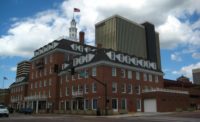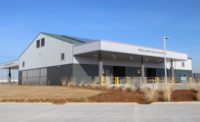There are a variety of considerations for specifying architectural building products on any project, everything from aesthetics and structural integrity to cost and environmental friendliness. For the construction of the Stack House apartments in Seattle, metal composite material (MCM) from Citadel Architectural Products Inc. helped meet these goals and were able to play a role in the project receiving LEED Platinum certification.
Stack House Apartments makes up approximately half of the Block 10 project in the South Lake Union District and includes two newly constructed residential buildings. The new apartment buildings are located in the same block as the historic Supply Laundry Building, which was renovated for retail, restaurant and office occupancy. The Supply Laundry Building is flanked by a large stack from its days as a manufacturing plant. That’s where Stack House Apartments get its name.
Located near some of the Emerald City’s most famous cafes, galleries and shops, Stack House offers a variety of floor plans, including studio, one-, two- and three-bedroom homes, as well as lofts and townhomes. The Stack House Web site states: “combining green living with warm character, fast technology and sleek, good looks, Stack House will be your soothing urban refuge.”
A variety of wall products were used on the apartment buildings to ensure a sleek, attractive look. Envelope 2000 panels from Citadel accounted for 23,700 square-feet of wall coverage. The finish for the panels was Clear Satin Anodized, projecting a bright silver appearance.
“We like to use multiple products to break up the massing of the building,” says Ana Parke, RA at Runberg Architecture Group in Seattle. “We use Citadel products quite a bit on the ground levels because it’s an upgrade from other products. It’s the best way to get bang for your buck.”
Parke says using multiple products helps the project meet budgetary goals, using more economical products where they still provide the required aesthetic. In addition to the metal composite material from Citadel, other wall products included metal panels and cement composite façade panels.
These siding products were installed by AVA Siding of Covington, Wash. Project manager/estimator Alex Udod says AVA Siding was on site for about eight months. “This was a great job to work on,” Udod says. “The Envelope 2000 RV system was perfect for this project. It looks great and was pretty easy to install.
“It’s available in larger sheets than other MCM panels, so we were able to use 4-foot by 8-foot and 5-foot by 10-foot sheets. The larger panels give the building a cleaner look.”
Envelope 2000 from Citadel is a composite panel, consisting of two aluminum skins bonded to a thermoset phenolic resin core. Standard sizes available include 8-, 10- and 12-foot lengths, in widths measuring 4 or 5 feet. It is designed for use as exterior cladding on walls, canopies, fascia and accent bands. Udod says his crew also installed Envelope 2000 as a soffit panel on the Stack House project.
Sustainable products, like Envelope 2000, were a contributor to Stack House achieving LEED Platinum certification. Apartments feature Energy Star-rated appliances and high-efficiency water fixtures. The complex offers complimentary electric charging spaces, on-site Zip Cars, bike storage and a community garden.
In addition to LEED Platinum certification, the project was recognized as the Outstanding Multifamily Project of the Year for the LEED for Homes Awards from the Green Building Council. Stack House also meets the Seattle 2030 District challenge for energy and water savings.




